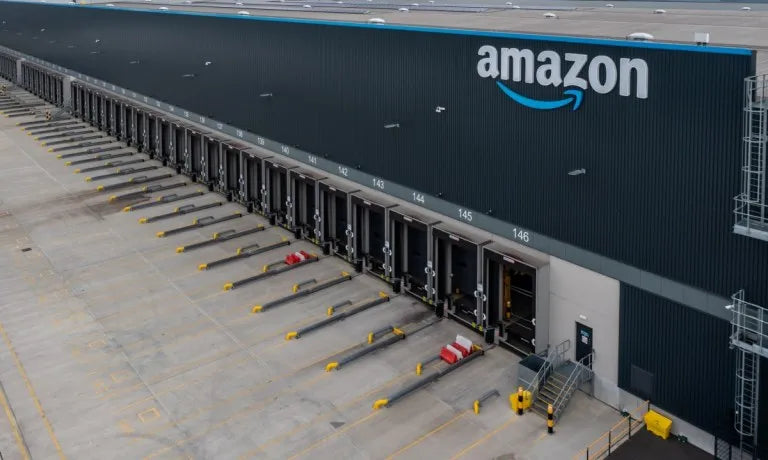
The Battle for Retail Supremacy: Amazon vs. Walmart
Table of Contents
- Key Highlights:
- Introduction
- Differing Philosophies: Amazon’s Tech-Driven Approach
- Walmart’s Integration of Traditional Strengths and Technology
- Automation, Intelligence, and the Talent War
- Logistics and Infrastructure Define the Delivery Arms Race
- Meeting the Evolving Consumer Where They Are
- FAQ
Key Highlights:
- Amazon and Walmart are engaged in a significant competition for market share, each employing unique strategies in the evolving retail landscape.
- While Amazon focuses on technology-driven solutions, Walmart emphasizes integration of digital and in-store experiences.
- Consumer habits show a growing trend of using both Amazon Prime and Walmart+, indicating that shoppers are increasingly valuing the strengths of each platform.
Introduction
The retail landscape is witnessing a seismic shift as two titans, Amazon and Walmart, redefine the future of shopping. Their contrasting strategies not only reveal their corporate philosophies but also reflect broader changes in consumer behavior and technology adoption. As Jeff Bezos prepares for a high-profile wedding in Venice, the business world remains captivated by this ongoing rivalry that extends far beyond mere sales figures. With both companies pouring resources into innovative technologies and logistics, the battle for retail supremacy is shaping how consumers engage with brands, shop for products, and experience services.
This article delves into the strategies employed by Amazon and Walmart, exploring their approaches to technology, logistics, consumer engagement, and the implications for the retail sector.
Differing Philosophies: Amazon’s Tech-Driven Approach
At the heart of Amazon's operations is a philosophy centered on technology and scalability. The company has built its empire on the principle of "build once, scale infinitely." This is evident in its ownership of a comprehensive tech stack, encompassing everything from cloud services to distribution networks. Amazon's Prime membership program serves as a crucial component of its retail flywheel, driving customer loyalty and repeat purchases.
Amazon’s commitment to artificial intelligence (AI) has positioned it as a leader in personalization and efficiency. Innovations such as the Titan AI model and partnerships with AI firms like Anthropic exemplify its strategy to control the technological landscape. By leveraging AI, Amazon enhances customer experiences, optimizes fulfillment processes, and streamlines infrastructure.
However, this tech-centric approach is not without challenges. The recent departure of AWS’ vice president of generative AI underscores the intense competition for top talent in the AI sector. With skilled professionals increasingly mobile, retaining expertise has become a critical concern for tech companies, including Amazon.
Walmart’s Integration of Traditional Strengths and Technology
In contrast, Walmart is leveraging its storied history in retail while modernizing its operations to meet contemporary demands. This involves a significant upgrade to its infrastructure and corporate culture, promoting a digital-first mindset. Unlike Amazon's focus on radical transformation, Walmart's strategy is one of integration—melding in-store shopping experiences with digital capabilities.
Walmart is embedding AI into the daily workflows of its vast workforce of 1.5 million store associates. By offering tools that enhance task management, real-time translation, and conversational support, Walmart is positioning its employees as vital components of its AI strategy. This democratized use of technology aims to amplify workforce capabilities rather than replace them.
The juxtaposition of Amazon's tech-centric model with Walmart's community-focused approach highlights the strategic diversity inherent in retail today. Both companies are converging on a shared goal: frictionless commerce. However, the pathways they take to achieve this goal differ significantly.
Automation, Intelligence, and the Talent War
As Amazon and Walmart ramp up their investments in AI, their operational philosophies continue to diverge. For Amazon, AI serves as an engine for driving efficiency and enhancing customer experiences. The company’s investments in foundational AI technologies underscore its commitment to building a robust tech ecosystem that can adapt to changing market demands.
Amazon's AI initiatives extend to consumer-facing services as well. For instance, the Ring security system now employs AI-powered alerts that provide contextual notifications based on detected movements. This move enhances user experiences by delivering more relevant information, showcasing Amazon's dedication to using technology to improve everyday life.
Conversely, Walmart's AI strategy is more focused on supporting its workforce and integrating technology into existing processes. By equipping employees with AI tools, Walmart aims to enhance productivity and streamline operations, which can lead to improved customer service and operational efficiency.
As both companies vie for talent in the AI sector, the competition has become increasingly fierce. The battle for skilled professionals not only impacts these giants but also shapes the future of technology in retail and beyond.
Logistics and Infrastructure Define the Delivery Arms Race
In the realm of logistics, speed has become a critical factor in consumer satisfaction. Both Amazon and Walmart are investing heavily to enhance their delivery capabilities, recognizing that consumers expect quick and reliable service.
Amazon's recent initiatives include a substantial push into rural markets, expanding its same-day and next-day delivery services to over 4,000 towns across the United States. This expansion is underpinned by a $500 million investment in a mega-warehouse located in Oregon, which is capable of stocking over 40 million items. By decentralizing its logistics network, Amazon is positioning itself to respond more effectively to local demand, leveraging AI to optimize inventory management.
Walmart, not one to be outdone, is piloting a network of "dark stores"—fulfillment centers that cater exclusively to online orders. These facilities, located in strategic areas, are designed to provide rapid delivery services, aiming to reach nearly 95% of the U.S. population within three hours. This innovative approach reflects Walmart’s commitment to enhancing its e-commerce capabilities while maintaining its traditional strengths in physical retail.
The competition in logistics is further intensified by promotional strategies. Amazon has extended its Prime Day event to four days, prompting Walmart and Target to launch competing sales initiatives. These promotional events are less about clearing inventory and more about capturing consumer attention and fostering long-term customer loyalty.
Meeting the Evolving Consumer Where They Are
The dynamics of consumer behavior in the retail sector are rapidly changing, with an increasing number of shoppers utilizing both Amazon Prime and Walmart+. Recent data indicates that nearly one in four U.S. consumers now hold memberships in both services, reflecting a significant shift in shopping habits. This trend suggests that consumers are not merely choosing one platform over the other; they are leveraging the strengths of both to maximize their shopping experiences.
Amazon continues to dominate in discretionary spending categories, particularly in electronics and household goods. Conversely, Walmart+ has carved out a niche in groceries and essential items, making it a go-to platform for consumers seeking everyday necessities. This dual membership phenomenon highlights the need for both companies to continuously innovate and adapt to consumer demands.
However, maintaining customer loyalty comes at a cost. For instance, Amazon's third-party sellers are increasingly raising prices to offset rising costs associated with returns and fulfillment services. Return fraud has escalated significantly, resulting in financial strain on sellers who rely on Amazon's Fulfilled by Amazon (FBA) program. While consumers enjoy the benefits of free and convenient returns, the associated backend costs are becoming a growing concern for sellers.
In this highly competitive and dynamic environment, adaptability emerges as a critical asset. Both Amazon and Walmart are racing towards an uncertain future, and how effectively they respond to consumer needs and technological advancements will ultimately determine their success.
FAQ
Q: How do Amazon and Walmart differ in their approach to technology? A: Amazon primarily adopts a tech-centric approach, focusing on building proprietary technologies and leveraging AI to enhance customer experiences. In contrast, Walmart integrates technology into its existing operations, utilizing AI to empower its workforce and improve service delivery.
Q: What strategies are Amazon and Walmart using to improve logistics? A: Amazon is expanding its delivery capabilities into rural areas and investing in mega-warehouses to optimize inventory management. Walmart is piloting "dark stores" to enhance its e-commerce fulfillment speed and reach a broader customer base.
Q: Why are more consumers using both Amazon and Walmart platforms? A: The increase in dual memberships among consumers indicates that they value the unique offerings of each platform. Amazon excels in discretionary spending, while Walmart is preferred for groceries and essential items.
Q: What challenges are Amazon's third-party sellers facing? A: Amazon’s sellers are dealing with rising costs related to returns fraud and fulfillment fees, prompting some to raise prices or reconsider participation in the Fulfilled by Amazon program.
Q: How are both companies addressing consumer expectations for delivery speed? A: Both Amazon and Walmart are heavily investing in logistics infrastructure to ensure faster delivery options, with Amazon focusing on a decentralized model and Walmart on strategic fulfillment centers.
Povećajte svoju e-trgovinu s našim nedeljnim uvidima i ažuriranjima!
Ostanite u skladu sa onim što se dešava u svijetu trgovine
Adresa e-pošte
Odabrano za Vas

27 June 2025 / Blog
Holt Renfrew's Leadership Transition: Sebastian Picardo's Impact on Canadian Luxury Retail
Pročitajte više
27 June 2025 / Blog
The Future of E-Commerce: How AI Shopping Agents are Set to Disrupt the Retail Landscape
Pročitajte više
27 June 2025 / Blog
